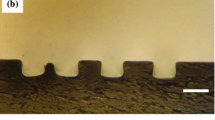Abstract.
The spatial pattern of acropetal and basipetal cytoplasmic streaming velocities has been studied by laser-Doppler-velocimetry (LDV) in the positively gravitropic (downward growing) rhizoids of Chara globularis Thuill. and for the first time in the negatively gravitropic (upward growing) protonemata. The LDV method proved to be precise and yielded reproducible results even when tiny differences in velocities were measured. In the apical parts of the streaming regions of both cell types, acropetal streaming was faster than basipetal streaming. Starting at the apical reversal point of streaming, the velocity increased basipetally with the distance from that point and became fairly constant close to the basal reversal point; subsequently, the velocity decreased slightly acropetally as the apical reversal point was again approached. There was no change in velocity at the basal reversal point. However, at the apical reversal point there was an abrupt decrease in velocity. The pattern of the ratio of acropetal to basipetal streaming velocity (VR) was a function of the relative distance of the site of measurement from the apical reversal point rather than a function of the absolute distance. Upon inversion of the rhizoids, the VR decreased on average by 3.8% (±0.4%), indicating that the effect of gravity on the streaming velocity was merely physical and without a physiological amplification. Rhizoids that had developed on the slowly rotating horizontal axis of a clinostat, and had never experienced a constant gravity vector, were similar to normally grown rhizoids with respect to VR pattern. In protonemata, the VR pattern was not significantly different from that in rhizoids although the direction of growth was inverse. In rhizoids, oryzalin caused the polar organization of the cell to disappear and nullified the differences in streaming velocities, and cytochalasin D decreased the velocity of basipetal streaming slightly more than that of acropetal streaming. Cyclopiazonic acid, known as an inhibitor of the Ca2+-ATPase of the endoplasmic reticulum, also reduced the streaming velocities in rhizoids, but had slightly more effect on the acropetal stream. It is possible that the endogenous difference in streaming velocities in both rhizoids and protonemata is caused by differences in the cytoskeletal organization of the opposing streams and/or loading of inhibitors (like Ca2+) from the apical/subapical zone into the basipetally streaming endoplasm.
Similar content being viewed by others
Author information
Authors and Affiliations
Additional information
Received: 4 October 1999 / Accepted: 4 November 1999
Rights and permissions
About this article
Cite this article
Ackers, D., Buchen, B., Hejnowicz, Z. et al. The pattern of acropetal and basipetal cytoplasmic streaming velocities in Chara rhizoids and protonemata, and gravity effect on the pattern as measured by laser-Doppler-velocimetry. Planta 211, 133–143 (2000). https://doi.org/10.1007/s004250000273
Issue Date:
DOI: https://doi.org/10.1007/s004250000273




